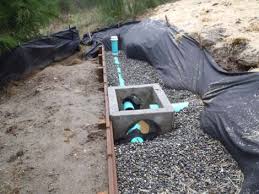

BMP stands for Best Management Practices. It basically is a fancy way to say the control of water runoff to reduce water pollutants. Now that you have your foundation poured you can start your drainage installation. If you are installing footing drains then do this first. I recommend only using schedule 40 perforated PVC for your footing drains. The black corrugated roll pipe is too cheap and easily collapses. Now run your perforated pipe on the perimeter of the foundation basically at the level of footings gluing each section. Check your permits and see if there is restrictions on hooking up your footing drains to downspout lines. If so just remember that most areas do not state you have to have footing drains. The footing drains will be completely covered and the inspector doesn't even need to know that you have them. Now run your downspout lines around foundation and put stubs for where your gutters will be coming down. This pipe should also be schedule 40 but not perforated. Its not a bad idea to have a couple clean-out locations around house for your drainage lines. The location of downspouts should be on plans along with your drainage. For my house it was a simple system. Two tight lines that ran 60 feet connecting to a catch basin. The catch basin was in the center and it had a line on each side running 15 feet with perforated pipe. The idea is that the water comes down your gutters and runs into the catch basin. Once the catch basins fill up they let water out the side through the perforated pipes and into your drainage ditch full of washed rock. This is where the water disperses into the ground. The county also called for a notch board behind the ditch to control the water flow. It basically is a pressure treated 2 by 12 with v cuts the length of board. Every design will be different so make sure you look at your permits carefully. The drainage BMP was something I had to have inspected and signed off. At the time of inspection everything was back filled and the inspector just made sure it was in place and installed according to permit. Its a good idea to take pictures with a tape measure showing the depth of pipe to top of grade. This way the pictures can be provided to inspector for correct depth installation. Pictures should be taken in every step of the process. You never know when you might need to break them out. Just make sure you know what is in the picture. You don't want a picture of someone standing on your roof without fall protection or a pipe in the picture that you said was not installed. The Drainage BMP inspection can be done at any time, but I recommend getting it out of the way before you have supplies stacked up all over the place. If you are paying a contractor to install your system make sure your inspection is completed before paying in full. If you got the permit for temp power the same contractor could also install the conduit that your power will be running through. I will be explaining that next.